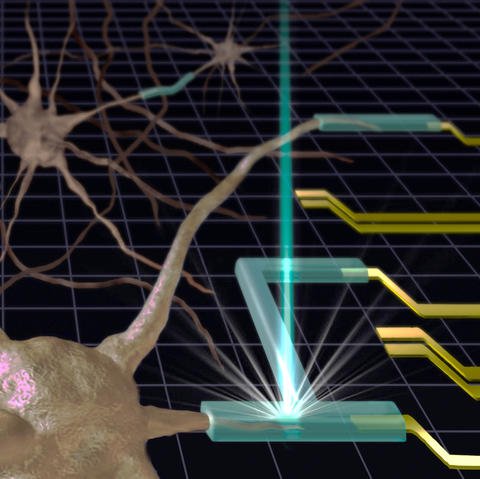Creation of tiny medical devices for the body can be now quickly started by Scientist's new method
Hello #Hivers, hoping you are having a good week start. Today we will explore a very innovative development in the field of medical sciences with the help of which creation of tiny devices for the body could now be quickly possible by Scientist's new innovations which we will be discussing in detail in the due course throughout. But before jumping into the main content, as always let's have some quick basics discussion which will help in a better understanding of the content of this article.

Image credit: A. Strelcov/NIST (Source: NIST )
3D printing or added substance manufacturing could be a cycle of constructing 3-dimensional sturdy things from a complicated record. The formation of a 3D written object is accomplished utilizing added substance measures. In an extra substance measure, an associate item is formed by setting down progressive layers of fabric until the article is made. each one of those layers may be viewed as a meagerly cut cross-segment of the article. 3D printing is a few things contrary to reductive collecting that is removing/emptying a small amount of metal or plastic to Illustrate a process machine. 3D printing empowers you to form complicated shapes utilizing less material than typical collecting strategies.
Scientists at the National Institute of Standards and Technology (NIST) have designed up another strategy for 3D-printing gels and different delicate materials. Distributed in another paper, it can build complicated structures with nanometer-scale accuracy. Since various gels are viable with living cells, the new technique might begin the creation of delicate very little clinical gadgets, for example, drug conveyance frameworks or pliant cathodes which will be embedded into the human body.
A customary 3D printer makes robust structures by creating sheets of fabric - often plastic or elastic - and developing them layer by layer, kind of like a lasagna until the whole article is made.
Utilizing a 3D printer to manufacture an item made of gel is "a touch, even more, a sensitive cooking measure," said NIST analyst Andrei Kolmakov. In the standard strategy, the 3D printer chamber is loaded up with a soup of long-chain polymers - long gatherings of particles reinforced together - breaking down in the water. At that point, "flavors" are included - unique particles that are delicate to light. At the point when light from the 3D printer initiates those extraordinary atoms, they line together with the chains of polymers so they structure a cushy weblike structure. This framework, actually encompassed by fluid water, is that the gel.
Regularly, current 3D gel printers have used bright or noticeable optical maser light-weight to start the event of the gel platform. Be that because it may, Kolmakov associate degreed his partners have to target an alternate 3D-printing technique to form gels, utilizing light emissions or X-beams. Since these styles of radiation have a better vitality or shorter frequency than bright and obvious light, these pillars are often all the additional firmly engaged and during this approach turn out gels with better basic detail. Such detail is truly what's needed for tissue coming up with and numerous other clinical and natural applications. Electrons and X-beams offer a subsequent favorable position: They don't need a unique arrangement of atoms to start the development of gels.
However, at present, the wellsprings of this firmly centered, short-frequency radiation - examining electron magnifying instruments and X-beam magnifying lens - can just work in a vacuum. That is an issue because in a vacuum the fluid in each chamber vanishes as opposed to shaping a gel.
Kolmakov and his associates at NIST and the Elettra Sincrotrone Trieste, in Italy, tackled the issue and exhibited 3D gel imprinting in fluids by putting an ultrathin boundary - a meager sheet of chemical element compound - between the vacuum and therefore the fluid chamber. The dainty sheet shields the fluid from dissipating (as it might typically neutralize a vacuum) nonetheless permits X-beams and electrons to infiltrate the fluid. The technique authorized the cluster to utilize the 3D-printing thanks to contending with build gels with structures as little as a hundred nanometers (nm) - around multiple times additional slender than a human hair. By processing their strategy, the scientists hope to engrave structures on the gels as little as fifty nm, the scale of a touch infection.
Some future structures created with this methodology could incorporate adaptable injectable anodes to screen mind movement, biosensors for infection location, delicate miniature robots, and structures that can copy and interface with living cells and give a medium to their development.
Thank you all for going through my blog. I hope that you all enjoyed this recent discovery. I write various articles related to science. For more such quality articles to read please follow me @science-popper.
See you people tomorrow. Will be coming up with such interesting contents. Till then take and be safe!!
Reference:
Journal Reference:
- Tanya Gupta, Evgheni Strelcov, Glenn Holland, Joshua Schumacher, Yang Yang, Mandy B. Esch, Vladimir Aksyuk, Patrick Zeller, Matteo Amati, Luca Gregoratti, Andrei Kolmakov. Electron and X-ray Focused Beam-Induced Cross-Linking in Liquids: Toward Rapid Continuous 3D Nanoprinting and Interfacing using Soft Materials. ACS Nano, 2020; DOI: 10.1021/acsnano.0c04266
Thanks for your contribution to the STEMsocial community. Feel free to join us on discord to get to know the rest of us!
Please consider supporting our funding proposal, approving our witness (@stem.witness) or delegating to the @stemsocial account (for some ROI).
Thanks for using the STEMsocial app and including @stemsocial as a beneficiary, which give you stronger support.
Congratulations @science-popper! You have completed the following achievement on the Hive blockchain and have been rewarded with new badge(s) :
You can view your badges on your board and compare yourself to others in the Ranking
If you no longer want to receive notifications, reply to this comment with the word
STOPDo not miss the last post from @hivebuzz: